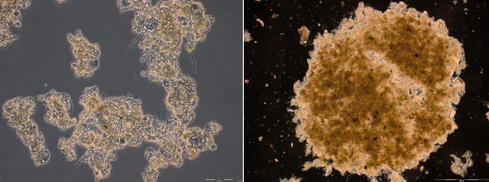KontiGran
Aerobic granular sludge in continuous flow-operation systems
Duration:
2015-2018
Financing:
BLMFUW
download final report (german):
Link BLMFUW
Contact:
Lydia Jahn ![]() ljahn(at)iwag.tuwien.ac.at
ljahn(at)iwag.tuwien.ac.at
Short description
In the last century the activated sludge process has become the most commonly used process for the biological wastewater treatment. Principal of the purification are biological metabolic processes to remove organic pollutants from the wastewater. The involved microorganisms build hereby fine flocs, which are called activated sludge. Focus of various research is to optimize the floc structure of activated sludge to form much larger and denser structures. Aerobic granular sludge reach compared to fine sludge flocs a much higher settling performance and reduces further the required volume for sludge separation. At the same time, it is possible to operate with higher biomass concentrations in the activated sludge stage. These structural properties allow it to design compact wastewater treatment systems, which is an attractive opportunity of saving space, especially for metropolitan areas. Previous studies relate to discontinuously fed wastewater treatment plants, so-called SBR. The granulation in SBR is thereby realized by the application of short settling times, which cause the washout of slowly settleable biomass, whereas biomass with good settling properties is maintained in the system.

Figure: fine flocky activated sludge (left), compact granular biomass (right)
The project “KontiGran” focuses the effects of different SBR settings (cycle time, aeration, etc.) on the cleaning performance and the expected impacts on the further sludge treatment (sludge digestion, dewatering). Moreover, the stability of the cleaning performance at different loading rates and nutrient conditions are to evaluate with the investigations and the emissions of climate-relevant N2O. Since most of municipal wastewater treatment plants in Austria are designed as continuous-flow system, another focus of the project is to develop a strategy, which ensures the granulation and the operation of aerobic granular biomass in these kind of activated sludge systems. A basic step for the continuous-flow operation is the transfer of SBR phases to separate spatial tanks, wherein the requirements for the granulation are ensured. In detail, the effects of different operation settings on the granulation process have to be evaluated.
[back]


